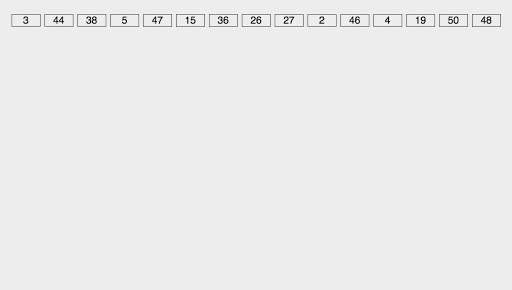

기수 정렬은(radix sort)은 값을 비교하지 않는 특이한 정렬이다. 기수 정렬은 값을 놓고 비교할 자릿수를 정한 다음 해당 자릿수만 비교한다. **기수 정렬의 시간 복잡도는 O(kn)**으로, k는 데이터의 자릿수를 말한다.
기수 정렬 수행 방식






public class 수_정렬하기3 {
public static void main(String[] args) {
Scanner scan = new Scanner(System.in);
int N = scan.nextInt();
int[] arr = new int[N];
for (int i = 0; i < N; i++) {
arr[i] = scan.nextInt();
}
radixSort(arr);
for(int i : arr){
System.out.println(i);
}
}
public static void radixSort(int[] arr) {
// 가장 큰 자릿수 찾기
int maxDigit = getMaxDigit(arr);
// 자릿수별로 정렬
for (int i = 1; i <= maxDigit; i++) {
countingSort(arr, i);
}
}
// 배열에서 가장 큰 자릿수를 찾는 메소드
private static int getMaxDigit(int[] arr) {
int maxDigit = 1;
int base = 10;
for (int num : arr) { // 108
int curDigit = 1;
while (num >= base) {
base *= 10;
curDigit++;
}
if (curDigit > maxDigit) {
maxDigit = curDigit;
}
}
return maxDigit;
}
// 자릿수 기준으로 counting sort를 수행하는 메소드
private static void countingSort(int[] arr, int digit) {
int[] countingArray = new int[10];
int[] outputArray = new int[arr.length];
int divisor = (int) Math.pow(10, digit - 1);
// 자릿수 기준으로 counting array를 채움
for (int num : arr) {
int index = (num / divisor) % 10; // 8/1 % 10 = 8
countingArray[index]++;
}
// counting array를 누적합 배열로 변경
for (int i = 1; i < countingArray.length; i++) { // countingArr = [2, 2, 7, 1, ...]
countingArray[i] += countingArray[i - 1]; // 2,4,11,12 ...
}
// output array에 숫자 삽입
for (int i = arr.length - 1; i >= 0; i--) {
int index = (arr[i] / divisor) % 10;
outputArray[countingArray[index] - 1] = arr[i];
countingArray[index]--;
}
// output array를 원래 배열에 복사
for (int i = 0; i < arr.length; i++) {
arr[i] = outputArray[i];
}
// System.arraycopy(outputArray, 0, arr, 0, arr.length);
}
}
public class 수_정렬하기3_2_10989 {
public static void main(String[] args) {
Scanner scan = new Scanner(System.in);
int N = scan.nextInt();
int[] arr = new int[N];
for (int i = 0; i < N; i++) {
arr[i] = scan.nextInt();
}
int maxDigit = getMaxDigit(arr);
radixSort(arr, maxDigit);
for (int i : arr) {
System.out.println(i);
}
}
private static int getMaxDigit(int[] arr) {
int maxDigit = 1;
int base = 10;
for (int num : arr) {
int curDigit = 1;
while (num >= base) {
base *= 10;
curDigit++;
}
if (curDigit > maxDigit) {
maxDigit = curDigit;
}
}
return maxDigit;
}
public static void radixSort(int[] arr, int maxSize) {
int[] output = new int[arr.length];
int jarisu = 1;
int count = 0;
while (count != maxSize) { // 최대 자릿수만큼 반복
int[] bucket = new int[10];
for (int i = 0; i < arr.length; i++) {
bucket[(arr[i] / jarisu) % 10]++; // 1의 자리부터 시작
}
for (int i = 1; i < 10; i++) {
bucket[i] += bucket[i - 1]; // 누적합 배열을 이용해 index 계산
}
for (int i = arr.length - 1; i >= 0; i--) { // 현재 자릿수를 기준으로 정렬
output[bucket[arr[i] / jarisu % 10] - 1] = arr[i];
bucket[(arr[i] / jarisu % 10)]--;
}
for (int i = 0; i < arr.length; i++) {
arr[i] = output[i]; // 다음 자릿수를 이동하기 위해 현재 자릿수 기준 정렬 데이터 저장
}
jarisu *= 10;
count++;
}
}
}